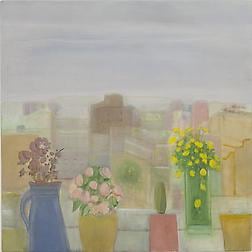
JANE FREILICHER Recent Paintings and Prints
by John Yau
TIBOR DE NAGY | MARCH 10 – APRIL 16, 2011
Jane Freilicher embarked upon her enduring subject in the mid 1950s, at the height of Abstract Expressionism. For nearly 60 years, and through the comings and goings of different styles (Pop art, Minimalism, Conceptual art, Neo-Expressionism), she has painted a vase of flowers in front of a window. The view outside is either urban or pastoral. Working within this deceptively simple and seemingly straightforward pairing, she has become a singular painter who has synthesized a core of formal preoccupations with a wide range of feelings in the most unexpected and often delightful ways. Her very particular way of seeing seems to have been there from the beginning. In “Early New York Evening” (1954), a cluster of stalks echoes the four ConEd smokestacks on the horizon, their plumes of dusky violet smoke briefly becoming flowers before dissolving into the violet evening sky. Such surprising visual rhymes clue us into the fact that Freilicher’s realism has always been a subtle brew of desire and observation, imagination and truthfulness.
Both the exhibition and the scale are modest, eight paintings and two lithographs, with the largest painting, “Yellow” (2009), measuring 32 by 40 inches. The colors are muted and air is hazy—it’s as if everything is losing its edge, on the brink of melting into the air. There is a table on which a glass vase holds a few different flowers, some of which are yellow, along with a small sculpture of a torso, a tin can, a magenta vase (possibly a Van Briggle), and some postcards and photographs, leaning against an invisible support and curling on the table. On the other side of this landscape of ghostly sentinels is the city, for the table has been pushed up against a window. You don’t see the window frame, so the outside and inside worlds meet, and you cannot tell where one ends and the other begins. Is that a postcard or a building? It is this state of confusion that Freilicher knowingly evokes. It calls forth a sense of vertigo and fragility, which the juxtaposition of an object-laden table and cityscape quietly enhance.
In the square “Harmonic Convergence” (2008), a vase of flowers stands on a round table, whose plane has tilted toward the picture plane. Beginning with the two rectangles closest to the table and flowers, there is an atmosphere of ambiguity. What are the rectangles behind the vase? Buildings or paintings, forms or planes, volumes or flat surfaces? The artist declares that they are both, that they are buildings and paintings within a painting. Confusion, we discover for ourselves, can be both a pleasure and the beginning of reflection. The material world becomes insubstantial. It seems that Freilicher is recording the process of fading from this world, the journey all of us have undertaken.
As the sculptor Joyce Robins told me the night before I went to see the show: “Freilicher is our Morandi.”